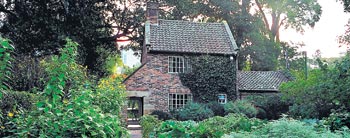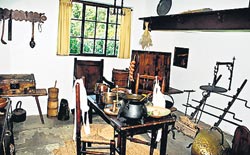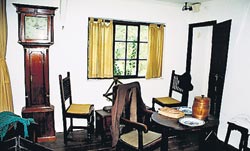
Exploring a great explorer’s humble beginningsChamari Senanayake visits the home of Captain James Cook’s parents in Melbourne In the heart of Melbourne city, there lies an English cottage that transports visitors into history, providing a glimpse of rural life in England in the 18th Century. This cottage, in the Fitzroy Gardens, is the oldest building in Australia. Built in 1755 at Great Ayton in Yorkshire, England it was the home of James and Grace Cook, parents of the world-renowned explorer, cartographer and astronomer, Captain James Cook. The Fitzroy Gardens is a 150-year-old Victorian-style garden with European plants, fountains, statues and pathways and was the ideal place for the Cooks’ cottage to be placed when it was dismantled and shipped to Melbourne in 1934. The cottage was bought for the City of Melbourne by Sir Russell Grimwade and was carefully put together just as it was at the cottage’s original Yorkshire garden.
For most people, life in rural England in the 18th century revolved around the house and garden. Although their son later became one of the world’s greatest explorers, for James and Grace Cook this was the humble home that they spent most of their time.Before you enter the cottage, you can see the old fashioned doormat and the mounting block that helped riders get on the horses. The English-style bricks have irregular shapes as before the industrial revolution, bricks were crafted by hand. Then, there is the ivy that grows on the wall, and the chimney that you can see from far. As you enter, the first sight is of garden tools hanging neatly on the wall. Then visitors enter the living room and kitchen area, where the family spent most of their time. The same fire place was used for cooking as well as heating, and the original iron pots used for cooking are still on display. Visitors to this room travel back to the past and see James and Grace Cook with their children having their meals by candlelight and the glow from the fire place. Next to the main room is the small children’s bedroom, with beds covered with straw mattresses. It is believed that children were encouraged to sleep sitting upright to promote better health and height. You can walk up the creaky wooden stairway to the common living room and main bedroom. The 18th century furniture gives an idea of the styles of the olden days, including the oak cradle and wool winder. Captain James Cook’s mother must have spent endless hours here, spinning and knitting, while his father must have done his reading and writing. There are also the candle holders and lamps and the brass warming pan that is equivalent to a modern day electric blanket.
Next is the main bedroom that may have been used by Captain Cook’s parents. There is also another small bedroom next to it, possibly for visitors, or later used by the older children. The beautiful garden is filled with European plants and herbs, and provided most food as well as local remedies for the household. Silver beet, pumpkin, potatoes and berries, lavender, rhubarb, rosemary, thyme, dill and mint can be easily recognized today. Visiting this cottage and garden is an amazing experience, a feeling of travelling back in time to the beautiful English countryside. Captain James Cook was born in 1728 at modern Middlesborough and his parents later moved to Great Ayton in Yorkshire where he attended the local school. He joined the Royal Navy as an ordinary seaman in 1755, the same year the cottage was built. Cook made three voyages to the Pacific Ocean, achieving the first European contact with the eastern coastline of Australia, the European discovery of the Hawaiian Islands, and the first recorded circumnavigation and mapping of Newfoundland and New Zealand. Cook accurately charted many areas and recorded several islands and coastlines on European maps for the first time. His achievements can be attributed to a combination of seamanship, superior surveying and cartographic skills, courage in exploring dangerous locations to confirm the facts (for example dipping into the Antarctic circle repeatedly and exploring around the Great Barrier Reef), ability to lead men in adverse conditions, and boldness both with regard to the extent of his explorations and his willingness to exceed the instructions given to him by the Admiralty.
Captain Cook's most famous ship is the Endeavour, in which he sailed on his first voyage round the world. On his second voyage he sailed in the Resolution accompanied by the Adventure. And on his third voyage he sailed in the Resolution, again, accompanied this time by the Discovery. The names of these four ships are said, by some, to sum up Cook's own character. But they weren't the only vessels he had commanded, nor in which he had sailed. There was the Eagle, Pembroke and Grenville, whilst he was in the Navy, and the Freelove and Three Brothers, amongst others, whilst he was learning the ropes before that. The name ‘Captain James Cook’ is linked eternally with the name ‘Endeavour’, as she is most famous for her successful voyage around the world and discovery of Australia. Although her fate is not entirely known, it is said that in 1793 she put in to Newport with a cargo of oil and ran aground. She was purchased by John Cahoon and broken up. It is fitting that a piece of her timbers is to be found in a small museum that has been established at Kurnell, Botany Bay, New South Wales, where Cook made his first landing on Australian soil. One of her cannons, which was raised from Endeavour Reef, now can be seen in perfect condition there. Similar was the fate of Captain James Cook. He was killed by the native Hawaiians in 1779 and only the half burnt body was later given to the second in command of his ship and buried at sea. However, the ultimate respect was later given to ‘Endeavour’. In 1989, the National Aeronautics & Space Administration (NASA) christened a new Space Shuttle orbiter Endeavour which flew its first mission, highlighted by the dramatic rescue of a stranded communications satellite in May 1992. |
|| Front
Page | News | Editorial | Columns | Sports | Plus | Financial
Times | International | Mirror | TV
Times | Funday
Times || |
| |
Copyright
2007 Wijeya
Newspapers Ltd.Colombo. Sri Lanka. |


